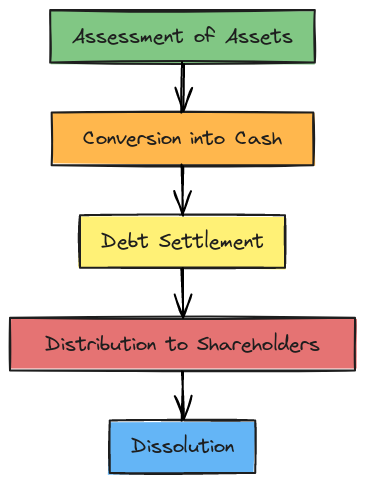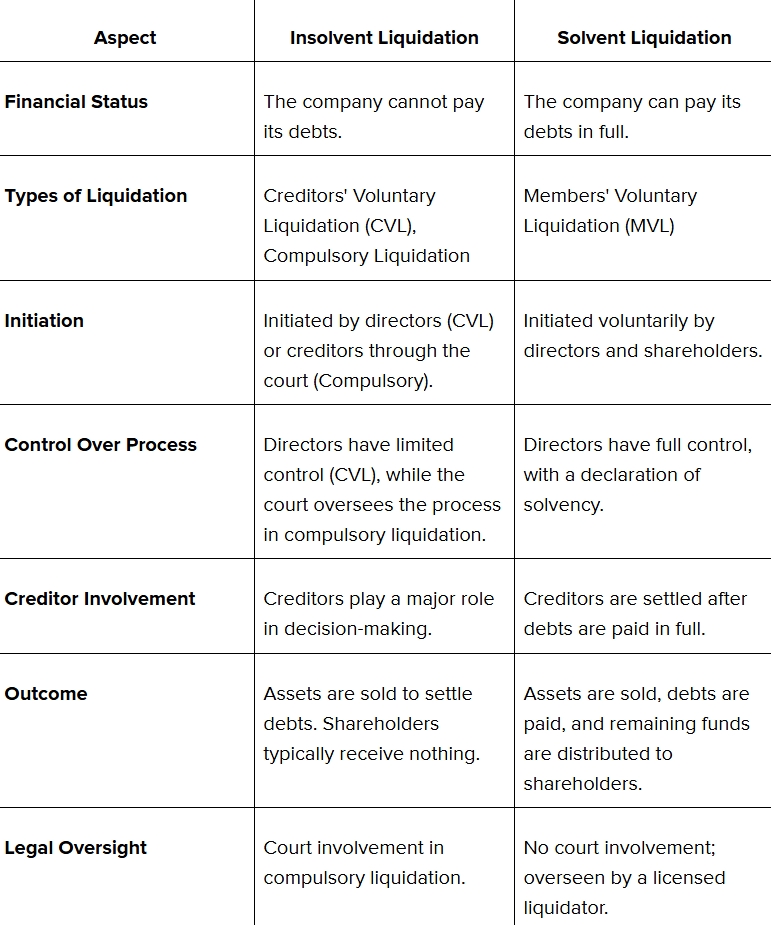
Liquidation is more than just a financial term; it signifies the end of a business journey.
In 2025, the United States saw over 11,000 bankruptcy filings by week 17, with Chapter 7 liquidation bankruptcies dominating the landscape, accounting for approximately 66% of all cases filed that week, with 7,320 filings. This spike emphasizes how crucial it is to understand what liquidation actually means.
Understanding the liquidation process is essential whether you're a creditor, investor, or business owner. It determines how assets are allocated, how debts are paid off, and how it impacts financial outcomes.
Let's look into the definition and process of liquidation and its significant aspects of business operations.
Liquidation refers to the process of winding up a company's affairs by selling off its assets to pay creditors and, if any funds remain, distributing them to shareholders. When a business is insolvent, i.e., unable to pay its debts on time, this process usually takes place.
The primary purpose of liquidation is to ensure that creditors are paid to the extent possible and that any remaining assets are returned to the owners. This legal process results in the company's dissolution, which signifies the end of its existence.
Knowing the goal of liquidation prepares you to investigate the different types of liquidation processes that companies might use.
Liquidation processes vary based on the circumstances leading to the company's closure. The two primary types of liquidation are voluntary and compulsory liquidation, each with distinct processes and conditions.
Voluntary liquidation occurs when the company's directors decide to wind up the business. It can be divided into two further categories:
A court-ordered process known as compulsory liquidation is often initiated by creditors who petition the court because of unpaid debts. In this instance, a liquidator is appointed by the court to oversee the asset sales and debt settlement.
Knowing the differences between compulsory and voluntary liquidation aids in choosing the best course of action, depending on the financial situation of the firm.
Now that we have a solid understanding of the different types of liquidation, let's explore the specific steps involved in the process.
The liquidation process follows a structured sequence of steps to ensure fairness and transparency in winding up a company's affairs. Each step aims to systematically address the company's assets and financial obligations.

To determine the amount of the company's liabilities and the value of its assets, a comprehensive assessment of its financial status is conducted. This is a crucial step in determining if the business is solvent or not.
In order to raise the funds needed, the company sells its property, inventory, and equipment. This ensures sufficient liquidity to pay off debts and other financial obligations.
The cash generated from asset sales is used to pay creditors in a specific order of priority. In accordance with the law, secured creditors receive payment before unsecured creditors.
Any money remaining after all debts have been paid off is given to shareholders. The distribution is done proportionally based on the ownership stakes of the shareholders.
The business is formally dissolved once its debts are paid off and the funds are distributed. Its registration is removed from the relevant company registry, and it no longer functions as a legal entity.
This well-organized approach ensures that the liquidation process is handled fairly and efficiently.
With the liquidation process clearly set, it's critical to understand the liquidator's responsibilities and the legal issues surrounding its management.
The liquidator is responsible for managing the entire liquidation process, ensuring that it proceeds smoothly and fairly. They play a vital role in protecting creditors' rights and following the law at every stage of the process.
For companies going through liquidation, South East Client Services inc (SECS inc) can offer expert guidance. Their services include handling asset management, ensuring compliance, and facilitating communication between creditors, ensuring a smooth and transparent liquidation process.
With the role of the liquidator clarified, it's critical to look at the differences between solvent and insolvent liquidation in order to understand the business implications.
In the liquidation process, you must understand the differences between solvent and insolvent liquidation. Below is a comparison table that highlights the key aspects of each, helping to clarify their distinctions.

Understanding the entire importance of the liquidation process in business closures requires a thorough understanding of the differences between insolvent and solvent liquidation. Let's wrap up by summarizing the key points.
Liquidation is an essential process for businesses unable to meet their financial obligations. Whether voluntary or compulsory, it involves selling assets, settling debts, and dissolving the company. Understanding the differences between solvent and insolvent liquidation is crucial for managing the closure effectively.
South East Client Services inc (SECS inc) provides valuable support beyond liquidation. They provide a thorough approach to business challenges by helping with financial management, guaranteeing compliance, and offering debt collection services.
If your business is facing financial difficulty, SECS can guide you through the process with expert care. Contact SECS inc today to discuss how their services can assist your business.